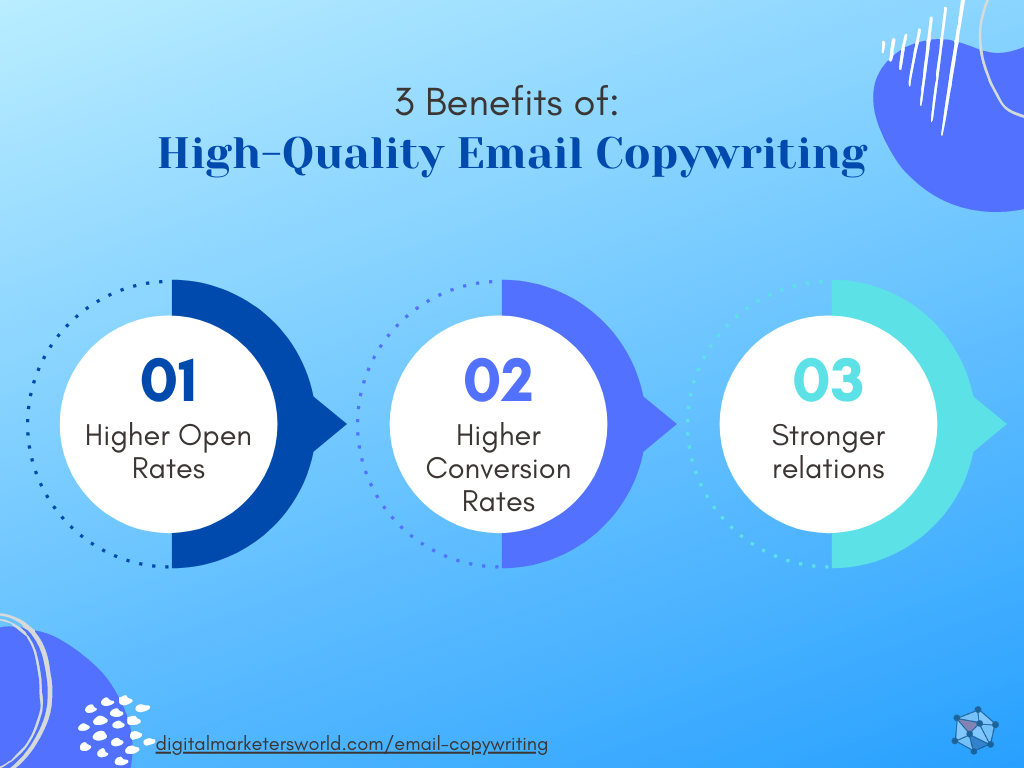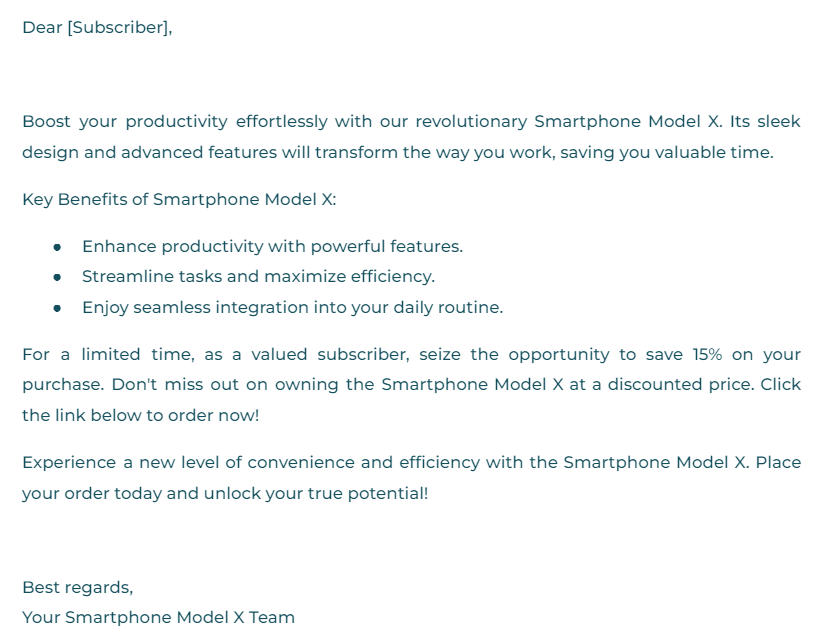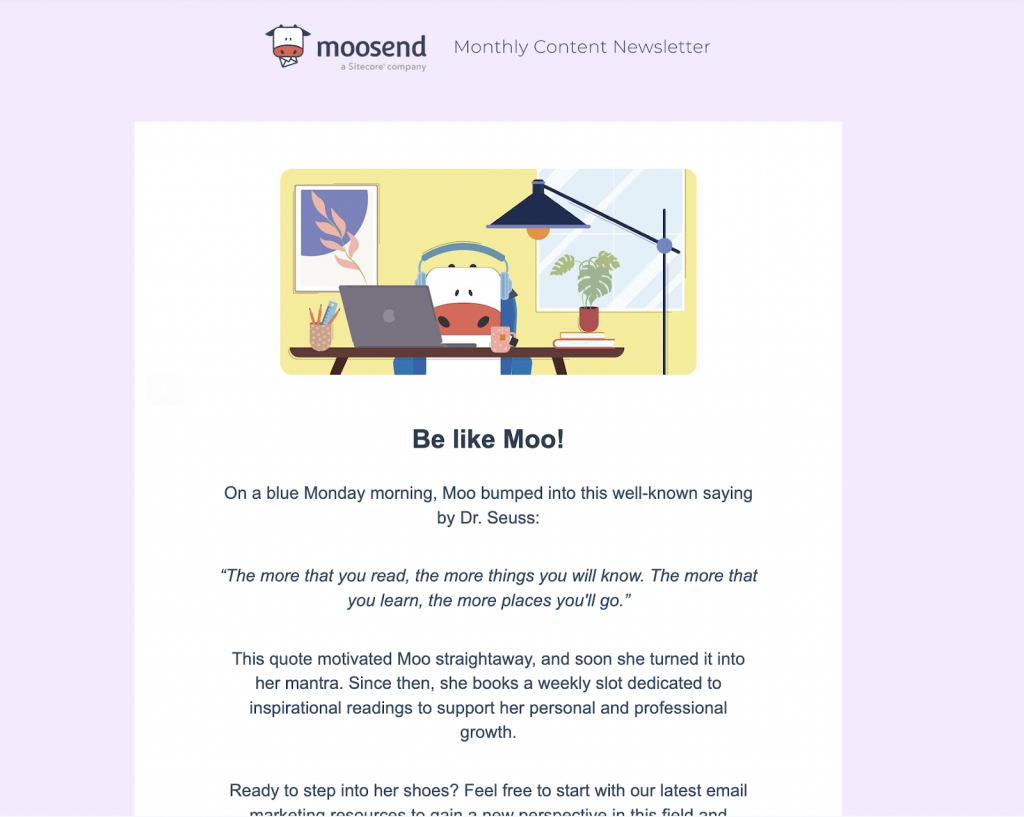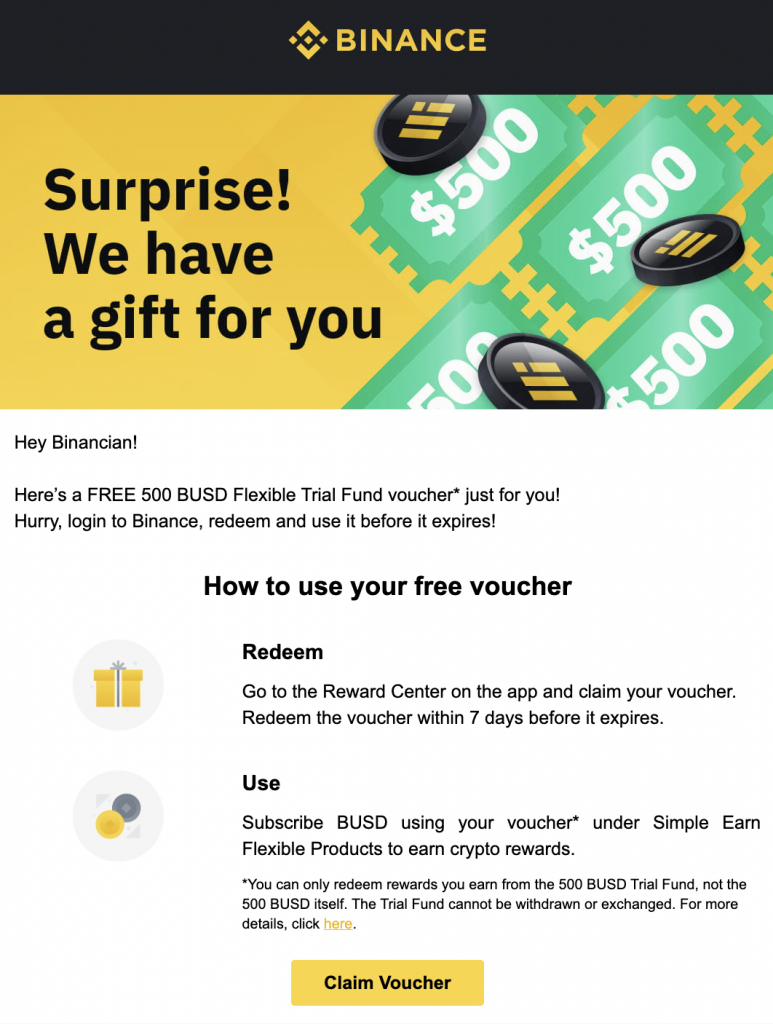Email Copywriting: Benefits, Best Practices & Examples to Follow
Have you ever stumbled upon marketing emails that were so good they felt like pieces of art? I sure have seen a couple, and I can imagine just how much time and effort the team behind them put into making those emails.
But is it really worth the struggle to make a good email copy?
The answer is a big YES.
In this article, we will not only underscore why you should improve your email copy but also outline some of the best practices for doing so.
What Is Email Copywriting?
Email copywriting is the discipline and art of creating email content that is compelling, effective, and able to attract the attention of recipients to convert them into your customers.
This discipline encompasses all of the content elements of your emails, starting from your subject line and introduction and ending with your signature.
Different parts of email content play different roles in the journey that your readers take, from noticing your email in their inbox to clicking on your call to action (CTA).
The subject line, for example, directly affects the open rate of your emails. Your email body copy and CTA, on the other hand, will decide how many readers that have opened your email will like your offering and choose to convert.
To help you better understand how a good email copy affects your campaigns, let’s first go over their key benefits.
The 3 Benefits of High-Quality Email Copywriting
It is common knowledge among digital marketers that the quality of content writing and copywriting can affect the effectiveness of your marketing efforts.
But does it apply to email copy too?
The answer is definitely yes, as a good email copy will let you enjoy a couple of key benefits.

Now let me explain these benefits in more detail.
Benefit #1: Higher open rates
When we talk about email copy, we refer to both the text in its body and the subject of your email.
To enjoy the benefit of higher open rates, you need to pay attention to the copywriting of your email subject line. Your subject line is the first piece of information your subscribers see and is what they use to decide whether it is worth opening your email.
In fact, for 47% of readers, the subject line is the sole factor behind the decision to open an email. Therefore, taking your time and optimizing it will catch the readers’ attention and make it more likely that they will click on your email.
Benefit #2: Higher conversion rates
As soon as your recipients have opened your email, your next goal is to convince them to take action (e.g. buy something, sign up for your product, etc.) after reading the body of your email.
You can increase the conversion rate of your emails by writing content that sparks the interest of your readers and convinces them that your offering is valuable. Some ways to spark their interest include pointing out your value proposition (e.g. get early access to our new feature), using power words (e.g. unlock your growth), and including CTAs.
To understand the impact of these best practices on your conversion rate, consider that adding a CTA alone can increase your clickthrough rates by 28%.
Benefit #3: Stronger relations
Finally, by doing your email copywriting right, you will become better at creating and maintaining relationships with your readers and customers.
Probably the main copywriting-related factor that can affect the quality of your relationships with your readers is the consistency of your brand voice in your messages.
By keeping your style of communication consistent and ensuring that it represents your brand voice, your users will begin gaining better familiarity with your company or products and building trust with you.
Now that we see how important good email marketing copywriting is, we can look at some of the best practices that can help you achieve the desired level of quality for your emails.
Most Important Email Copywriting Best Practices to Follow
As an integral part of content marketing, email copywriting is a complex discipline. People spend years honing their skills to become professionals at it.
But it does not mean that you will need years of hard work to get up to speed with your email copywriting skills.
In fact, you can vastly improve your game by following these 5 simple email copywriting tips.
Best Practice #1: Write short and concise emails
Back in the ‘90s, people would get excited every time they received an electronic mail and would read them, no matter the length. Back then, emails were a novelty and something to geek out about.
Today, however, emails have become commoditized. We receive so many messages a day that checking and cleaning up our inbox sometimes feels like a daily chore—I usually procrastinate and end up spending an entire hour over the weekend doing it.
Messages flooding your email inbox every day also mean that people do not want to spend much time reading each email. In fact, the average time spent reading an email is merely 10 seconds as of 2021, a 30% drop compared to 2018.
At an average pace, people will read only 50 – 125 words during these 10 seconds.
Therefore, if your message is much longer than the recommended size above, you risk people either reading only part of it or ignoring your message altogether. After all, the text was too long, and they did not want to commit their time to reading it.
To prove this point, take a look at this new product launch sales email.

Looks horribly long, doesn’t it? It may surprise you to know this email was only 212 words long. Now, let’s apply our content marketing skills to improve this cold email.

Unlike its predecessor, this version is much easier to read. Apart from trimming the message length to 115 words, we also added bullet points to make it easier for our email subscribers to scan over the benefits of our product.
Best Practice #2: Create engaging subject lines
The subject line of your email is the first piece of information your recipients see from your message. This line is where you leave your first impression on readers and hopefully spark their interest enough to open your email.
By writing a great subject line, you can improve your key email marketing metrics, specifically your open rate.
Luckily, writing an attention-grabbing subject line is not as hard as you might imagine. All you need to do is follow the industry standards in terms of the following:
- Keep it personal. Make sure your recipients understand that the email is personally addressing them. For instance, you can add their name or other personalizing pieces of data in the subject line, such as their city or interests. Here’s what this practice can look like: “Hey Anna, SEO Outreach Conference will kick off in Salzburg next week.”
- Spark curiosity with a question. If you know the pain points of your buyer persona, then your email marketing copy can ask them if they want to solve that pain. This strategy will entice them to open your mail to find your solution. Here’s a great example of this approach: “Tired of bounced emails? Get {your_product} to bring your bounce rate to zero.”
- Create a sense of urgency. The fear of missing out (FOMO) kicks in when customers understand that your lucrative offer will end soon and they might not be able to benefit from it. Subject lines that harness this urgency look like this: “Only 5 Business Class seats left for the price of Economy.”
Finally, don’t forget to keep subject lines short, around 60 characters. This number is the maximum size of the preview text that appears on most email services.
Best Practice #3: Avoid spam trigger words
You don’t want your target audience to think you are yet another “Nigerian Prince” who will involve them in a nasty scam. Nor do you want the security filters of your recipients’ email clients to go haywire and send your email to the dreaded “Spam” folder.
Therefore, you need to be careful with the format of your email and the words you choose for both the subject line and email body to avoid sounding spammy and untrustworthy. Here are a couple of typical elements of a spammy email:
- Overuse of punctuation: Be careful to use several exclamation marks, dollar signs, or similar characters in a row. Example subject line: “The Best Offer in the World!!!!! Get lots of $$$$. Join Now!!!!”
- Using capital letters only. This method is a “cheap” way to grab the readers’ attention, and most people associate it with spammy messages. Example subject line: “YOU HAVE WON A MILLION DOLLARS!!! GET IT NOW!!!”
- Exaggerated Promises. Unrealistic and inflated claims are another sign of a spammy message. Example subject line: “Lose 40 pounds in a week with this secret formula.”
You should also proofread your content, as grammar mistakes are another spam indicator. However, this rule does not apply to UGC emails, as you need to keep the content the way users originally wrote it.
Finally, avoid the excessive usage of trigger words that are usually associated with spammy emails, such as Free, Urgent, Act Now, Exclusive, and Guaranteed.
An example subject line demonstrating this case would be: “Free and Exclusive Offer! Act Now to Win a Million Dollars. Only available for a Limited Time!”
You can, however, use these words in limited numbers and in the right context.
Best Practice #4: Use the right CTAs
CTAs are either entire sentences or small phrases placed in the body or the subject line of the email that indicate the action the sender is hoping for the reader to take.
For instance, adding “Join our Beta Program by clicking on the link below” in the body of your email tells your readers that you expect them to click on the link you provide and sign up as a beta user.
To make sure that your CTAs perform well, follow these best practices:
- Be clear with your CTA. Including a CTA in your email will not help you at all if it is vague. Imagine you want to distribute your eBook among your users. If you use the CTA “Get Started,” few people will understand what you want. Using “Download our eBook now,” on the other hand, clearly identifies their next step.
- Speak about the value they get. You want to spark the interest of your users by telling them about the benefit they will receive from following your CTA. A good example of this approach is using “Sign up for Free” instead of simply “Sign up” as your CTA.
- Take advantage of visual CTAs. Don’t forget that email clients like GMail let you use a limited amount of HTML and CSS, so why not create a CTA that looks like a button and catches the eye of your readers instantly?
Finally, no matter how you formulate your CTAs, I recommend you always run A/B tests to optimize them iteratively.
Best Practice #5: Utilize power words
My final advice regarding your email marketing copy is to use the right words in your content. Your choice of words can either make or break your email marketing campaigns.
Power words are those words that can trigger an emotional response among your readers and encourage them to take action on your email.
For instance, saying, “become the leader everyone is looking up to” in an email offering leadership courses will trigger the emotional desire of users looking to improve their leadership skills in order to outshine their colleagues at work.
To conclude, no matter the type of email marketing you do, writing effective email copy is achievable with the right practices. If you follow these best practices in your next email, you will see a noticeable increase in the quality of your copy.
Now, to solidify what we have discussed, let’s look at a couple of real-life examples of great emails that incorporate these best practices in their copies.
3 Flawless Email Copywriting Examples
I must admit, after working with email campaigns more often, my favorite pastime has become finding and cataloging some of the best emails that companies have sent to their email lists.
I have three such examples below for you to examine for inspiration.
Example #1: Moosend
Moosend is an email marketing SaaS service that constantly creates professional content related to email marketing and distributes it among its users and those subscribed to its newsletter.
The email newsletter below is a great example of distributing such content.
Subject line: Moo 🐮 meets Dr. Seuss 💡

First of all, I love their subject line. It is short, includes words that grab the reader’s attention about Dr. Seuss, and uses emojis as visual elements, helping to stand out in the inbox of their users.
Pro tip: You can ask your design team to make compelling visuals for your content or you can make it yourself using a mockup generator or other self-serve design tools.
Speaking of content, I want to highlight the latter part of the email, where the Moosend team inspires readers to start reading educational content and then includes a call to action to help readers do it themselves.
Example #2: Fiverr
Fiverr is an online freelance work marketplace. The company is known for promoting some of the talent available on its platform to small business owners that can potentially hire them.
Here’s an example follow-up email with power words that promotes social media managers.
Subject line: Time to get social

Fiverr’s email here is a great example of using power words to engage potential customers. For instance, the header uses the term “success” to implant a thought in the minds of its readers that hiring SMM specialists from Fiverr will result in success.
Example #3: Binance
Finally, we have the cryptocurrency trading platform Binance.
They are known for using email promotions to bring back inactive users; here’s one example of such an email.
Subject line: Surprise! We have a gift for you!

Let’s begin with the subject line, where the Binance marketing team includes the main value proposition of their email—a gift.
Next, we can see just how short and concise the body of the email is, making it very easy to read. The Binance team has further improved readability by using images and bolded headers in the content.
Finally, there is the CTA that looks like a button and explicitly tells the reader what they will get after clicking on it (claim voucher).
Pro tip: Always make sure that your readers understand where the CTA is going to take them (e.g., opening an eCommerce landing page, a webinar signup, a marketing automation SaaS homepage, or a LinkedIn page).
If you would like to continue exploring email templates with case studies, we have 28 more examples for you to check out.
Now Over to You
The way you write emails and the words you use is much more important than you can imagine.
By making a compelling offering to your users, clearly stating your value proposition, and encouraging them to act upon your CTAs, you will be able to significantly increase the number of readers who decide to convert and become your paying customers.
While getting your email marketing strategy right is critical, you should also think about improving other marketing channels of yours. Check out our blog for compelling guides to improve all of your marketing channels.

Sona Kalantaryan is a senior digital marketer with a creative past. Big fan of high cinema and well-optimized landing pages. She authors guides by sharing the best practices and does it the right way!
